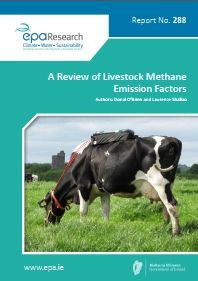Authors: Donal O’Brien and Laurence Shalloo
Summary: Teagasc and University College Dublin, with support from the Environmental Protection Agency (EPA) inventory team, reviewed the livestock methane emission factors used in the national greenhouse gas inventory approach for the agriculture sector and assessed potential reduction strategies.

Ireland is legally obliged as an EU Member State to reduce non-Emission Trading System (ETS) greenhouse gas (GHG) emissions. The target for the sector in 2020 is a 20% reduction on 2005 levels, with annual limits set for each year over the period 2013–2020. The non-ETS reduction target for 2030 is 30%. Ireland’s GHG emission projections for 2017 indicate that the nation is unlikely to achieve 2020 targets, because the dominant sectors, i.e. transport and agriculture, are expected to expand. Most of the projected growth in agricultural GHG emissions is expected to be in the form of methane emissions from livestock. Cattle and sheep are the main livestock sources of methane emissions. These methane sources represented 27% of non-ETS GHG emissions in 2016. Populations of cattle and sheep have increased since 2010 to nourish an increasing world population. Mitigating rising methane emissions from these species is difficult but possible, by improving farm practices or adopting new technologies. This mitigation, however, is only partially accounted for by current livestock methane emission factors.
Livestock methane emission factors are annual estimates of methane emissions per head. They are used with livestock statistics to estimate the change in national methane emissions. Methane emission factors are computed using country-specific methods or those provided by the Intergovernmental Panel on Climate Change (IPCC). Ireland uses country-specific tier 2 emission factors for cattle and default IPCC tier 1 emission factors for the remaining livestock species. Ireland’s tier 2 bovine methane emission factors are a major improvement on the tier 1 approach, but our review showed that some of these emission factors are based on activity data from 2003. The possibility of updating these activity data was determined by assessing the information collected by current inventory data sources and potential sources, namely the Teagasc National Farm Survey (NFS), Bord Bia sustainability surveys (SDAS and SBLAS) and the Irish Cattle Breeding Federation (ICBF). These data sources were also used to determine the potential to move to higher tier emission factors. The IPCC 2006 guidelines, national studies and countries’ GHG inventory submissions were reviewed to identify better methods to estimate emission factors.
Activity data are available to regularly update most of the key input variables used to quantify Irish livestock methane emission factors. These data are verified, where possible, for current data sources and the Teagasc NFS, and can be checked with data from Bord Bia and the ICBF. There is the potential to improve tier 2 methods or models for bovines by using recent Irish research on enteric methane instead of estimates from other nations. For sheep, methane emission factors can be improved by using the tier 2 model that was developed by Teagasc and provided during the project, instead of the current default tier 1 method. The new sheep model uses a similar approach as the tier 2 bovine emission model and can be operated using the current and new inventory data sources mentioned. Adopting the new sheep and bovine emission factors in the national inventory will improve its ability to capture the effect that mitigation strategies have on livestock methane emissions.
https://www.epa.ie/media/epa-2020/publications/research/Research_288_Thumbnail[1].jpg